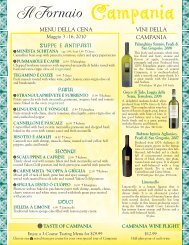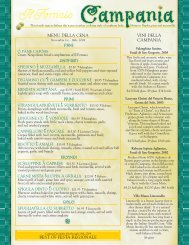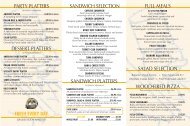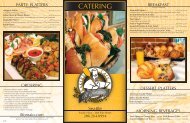a printable version of this menu in PDF format - Il Fornaio
a printable version of this menu in PDF format - Il Fornaio
a printable version of this menu in PDF format - Il Fornaio
Create successful ePaper yourself
Turn your PDF publications into a flip-book with our unique Google optimized e-Paper software.
Giorgio Lo Verde<strong>Il</strong> <strong>Fornaio</strong> Chef“Of course I can cook … I’m Sicilian!”Giorgio Lo Verde was born <strong>in</strong> Palermo, the capital <strong>of</strong> Sicily, and raised with fivebrothers and one sister – all <strong>of</strong> them cook. “It’s what Sicilians do. We don’t just eat; wealso enjoy cook<strong>in</strong>g food and shopp<strong>in</strong>g for it … preparation is just as important as themeal itself. Almost all boys and girls <strong>in</strong> Sicily grow up spend<strong>in</strong>g time <strong>in</strong> the kitchen.”Giorgio’s mother, Maria, and grandmother, Adele, were his first cook<strong>in</strong>g teachers and<strong>in</strong>stilled <strong>in</strong> him a sense <strong>of</strong> cul<strong>in</strong>ary adventure. “We learned to try all k<strong>in</strong>ds <strong>of</strong> foods and<strong>in</strong>gredients – especially seafood and fresh vegetables; that’s mostly what we ate <strong>in</strong>Palermo. How can you say you don’t like octopus if you haven’t tried it?” In addition tocook<strong>in</strong>g daily meals, Giorgio’s mom spent countless hours cann<strong>in</strong>g and preserv<strong>in</strong>gseasonal fruits and vegetables for the family to enjoy dur<strong>in</strong>g w<strong>in</strong>ter, when fresh producewasn’t available. “My mother, brothers, sister and I spent a lot <strong>of</strong> time up-to-our-arms<strong>in</strong> tomatoes.”His career has taken Giorgio from cul<strong>in</strong>ary school <strong>in</strong> Palermo to restaurants <strong>in</strong> Toronto,California’s San Joaqu<strong>in</strong> Valley and San Diego, but his roots rema<strong>in</strong> firmly <strong>in</strong> Sicily.Tonight’s <strong>menu</strong> features several dishes from Giorgio’s personal recipe file and others that rem<strong>in</strong>d him <strong>of</strong> home. “The Aranc<strong>in</strong>ial Sugo we serve are exactly like those my mother made for us – the traditional <strong>version</strong>, with meat, peas and rice. Mybrothers and I ate a LOT <strong>of</strong> these as kids.”M<strong>in</strong>estra chi Cucuzzi is made with “tennerumi” squash (Sicilian dialect for “tender”), unique to Sicilian cuis<strong>in</strong>e; its textureworks beautifully <strong>in</strong> soups. While meat is not commonly served <strong>in</strong> Sicily, Girelle con Filetto d’Agnello – roasted lamb <strong>in</strong>garlic-m<strong>in</strong>t sauce with caponata – captures the Mediterranean’s many <strong>in</strong>fluences on Sicilian cuis<strong>in</strong>e. For dessert, Palermo’stradition <strong>of</strong> artfully decorated pastry has <strong>in</strong>spired Giorgio’s own <strong>version</strong> -- Cassat<strong>in</strong>a della Contessa, a decadent, s<strong>in</strong>gleserv<strong>in</strong>gcake worthy <strong>of</strong> royalty. Buon Appetito!SiciliaThe Melt<strong>in</strong>g Pot <strong>of</strong> ItalyThe largest island <strong>in</strong> the Mediterranean, Sicilia is a culturalmelt<strong>in</strong>g pot. Its heritage – both historical and cul<strong>in</strong>ary –is as much Greek, Arab and Norman as it is Italian. Thesecultural <strong>in</strong>fluences, coupled with a sunny climate andfertile soil, give Sicilia its abundance <strong>of</strong> uniquefoods andcul<strong>in</strong>ary traditions.Sicilia is home to over half<strong>of</strong> all <strong>of</strong> Italy’s registered fish<strong>in</strong>gboats, so much <strong>of</strong> the Sicilian diet isbased on seafood. Swordfish is found <strong>in</strong> manydishes but so are lobster, mussels and shrimp,which are featured <strong>in</strong> our Spaghetti Mazara.We’ve specially imported Piacent<strong>in</strong>uEnnese cheese from Sicilia, impart<strong>in</strong>g aunique flavor <strong>in</strong> tonight’s Pumaroru cuPiacent<strong>in</strong>u Ennese. Eggplant, with its vary<strong>in</strong>gshapes and sizes, and fava beans f<strong>in</strong>d theirTrapaniPalermoCaltanissettaEnnaAgrigentoRandazzoMt. EtnaCataniaMess<strong>in</strong>away to the table <strong>of</strong>ten <strong>in</strong>GelaSiracusaSicilian pasta dishes. Pasta, believed toRagusahave orig<strong>in</strong>ated <strong>in</strong> Ch<strong>in</strong>a, was <strong>in</strong>troducedto Italy by merchants that first arrived<strong>in</strong> Sicilia.Many other <strong>in</strong>gredients, <strong>in</strong>clud<strong>in</strong>g semol<strong>in</strong>a, were also<strong>in</strong>troduced to Italy via Sicilian ports. Couscous, brought toItaly by Arabian merchants centuries ago, is featured as acomplement to the Pisci Spada cu Salmoriglio.Sicilia is known as the place where “the mounta<strong>in</strong>s meet thesea.” It is home to many beautiful beaches, magnificent peaksand Mount Etna. Etna is one <strong>of</strong> the most active volcanoes <strong>in</strong>the world and is <strong>in</strong> an almost constant state <strong>of</strong> eruption. Itssurround<strong>in</strong>g fertile volcanic soils support the vast v<strong>in</strong>eyardsand plentiful orchards spread across <strong>this</strong> dramaticallybeautiful island.












